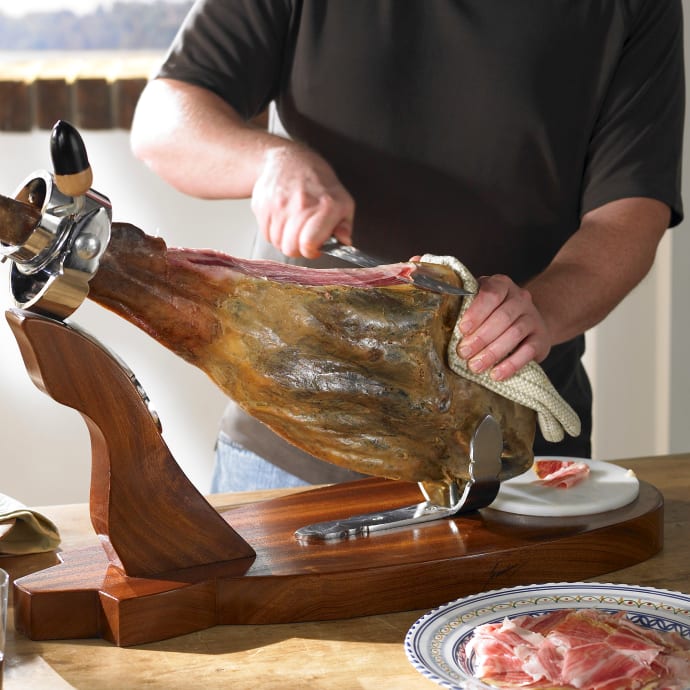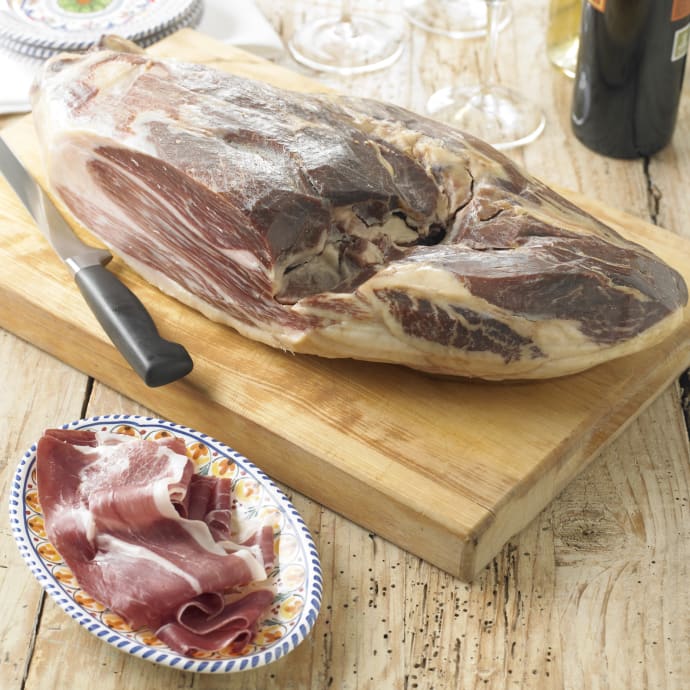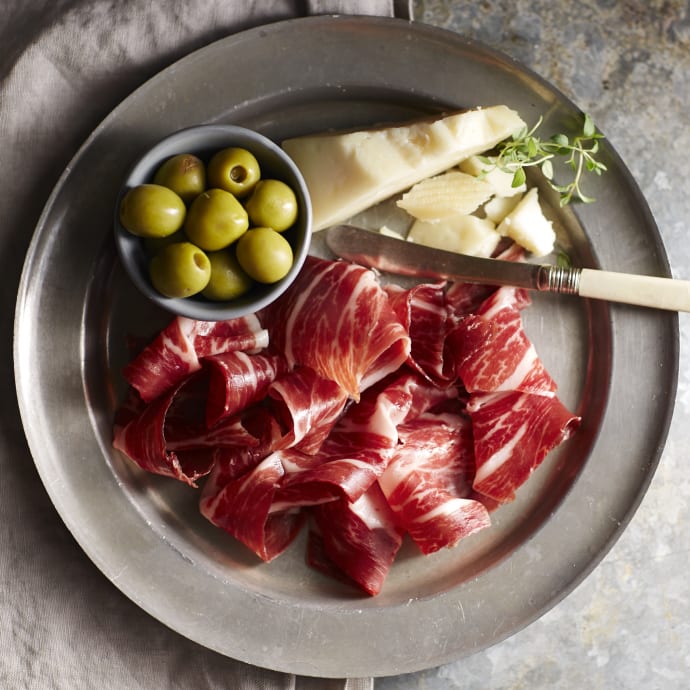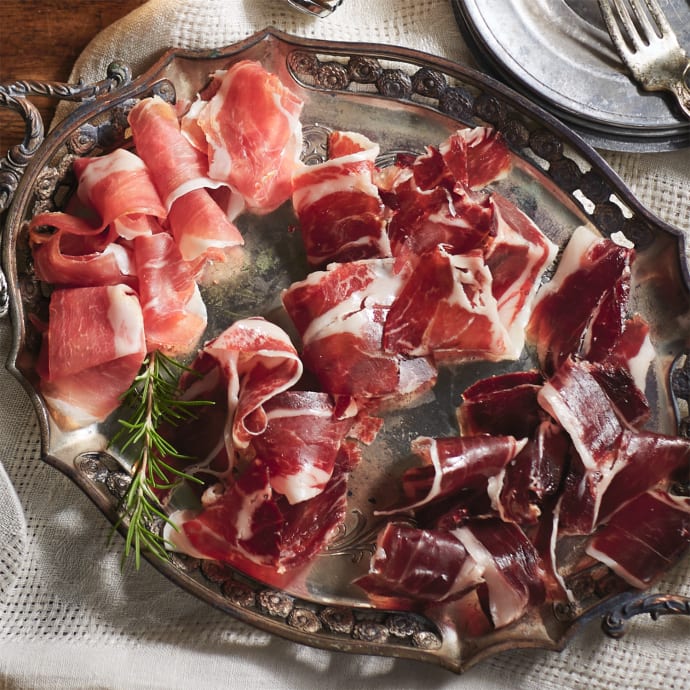
Highbrow Ham
Ft. Worth Star Telegram
-
April 12, 2006
The cure for ho-hum ham: salt, air, time and care
Amy Culbertson
At Easter, a cook's thoughts often turn to ham. But if your mental picture involves a giant pink football, sugar-glazed or covered with pineapple rings, oozing juice and cut into thick, soft slices, you have a whole world of ham yet to explore.
For many who are passionate about pork, those spiral-sliced babies that anchor holiday tables in so many households are wimpy, waterlogged, flabby, pale imitations. The real thing? Dry-cured ham, aged and coddled for months or even years, according to ancient farmhouse traditions.
Prosciutto from Italy. Jamon de serrano from Spain. Westphalian and Black Forest ham from Germany. American country ham from Virginia, Kentucky or Tennessee. Or the fabled pata negra, black-footed ham -- the crown of Spanish cuisine and so prized that aficionados are plunking down a couple hundred bucks' deposit each to secure a place on the waiting list for the first Iberico hams that will reach this country, in 2007 or 2008.
What makes these delicacies different from their city cousins? Almost everything, it turns out.
Your typical mass-produced supermarket ham, usually sold already cooked, has been wet-cured, or brine-cured -- injected with a curing solution containing salt and probably sugar, as well as sodium nitrate and other chemicals.
"Look at the ingredient line; if the first or second ingredient listed is water, that's a pumped product," third-generation country-ham producer Sam Edwards of Surry, Va., says disdainfully.
By contrast, the ingredients that come together to turn a leg of pork into a dry-cured ham are salt; possibly sugar or pepper or a few other spices; smoke, in some cases -- along with air, microbes, temperature and time.
Air makes the difference
Artisanal food expert and author Ari Weinzweig of the Zingerman's specialty food empire sums up the dry-curing process in an essay called A Campaign for Country Ham:
"Dry-cured hams are never baked, boiled or steamed. Rather, the "cooking" is done by a combination of salt, time and, sometimes, smoke. In the process, harmful bacteria are killed, 'good' molds develop to contribute to flavor, and water leaves the ham through evaporation, concentrating the ham's natural flavors in the process."
The curing and aging ritual varies in detail from region to region, but the outline is essentially the same: The trimmed ham legs are covered with salt; then, after a period of curing, are either smoked or hung directly in an aging room to air-dry.
Curing, of course, started out as "a way of preserving fresh meat to eat year-round," notes Edwards. As the hams age, they lose so much moisture that bacteria can't multiply in them, so they are safe at room temperature.
In the process, though, as the meat ripens and the complex proteins break down, a transformation in flavor is effected.
In some European ham traditions, the very air -- mountain or ocean breezes -- is considered essential in developing the ham's special flavor profile.
But most ham experts note that the ham starts with the pig -- its breed, its food and the way it is raised. Which brings us back to Spain's jamon Iberico, the Holy Grail of hamdom. It's made from a special breed of black pigs that roam oak woodlands in Spain.
"Iberico pigs are in effect free-range," says Don Harris, whose www.latienda.com company was the first to bring Spanish serrano hams to America through the Internet. The pigs forage on acorns, which in turn flavor their meat.
Harris' company has 230 names on a waiting list for the Iberico hams, which have never been available in America because the Spanish slaughterhouses -- though quite sanitary, Harris and others note -- did not conform to U.S. standards. Now that a slaughterhouse has been approved, "with two or three in the wings," Harris plans to be the first to sell Ibericos over here, for between $800 and $1,000 for a 16- to 18-pound ham.
Lots of bang for the pork
If you're not in the market for a thousand-dollar ham, don't worry: You don't have to go whole hog to explore the world of dry-cured ham. Yes, the per-pound prices do hover around the $20 mark, but a little bit goes a long way.
For an appetizer, you need only buy a couple of ounces of dry-cured ham per person; for seasoning or flavoring in cooking, you won't require much, either.
Less expensive is the smoked ham called speck, of Austrian origin. It's a real sleeper, touted by chefs and foodies such as Weinzweig. In a recent ham tasting at Central Market, some of us favored the speck over the pricier prosciutto and serrano.
And a bargain compared with its imported brethren is country ham made by small producers in the Southeastern U.S. -- though it's hard to find in these parts.
If you think dry-cured ham begins and ends with prosciutto, he insists, you're shortchanging yourself: "It's like saying all cheese is Cheddar, and I don't need to try the other cheeses because I've already eaten Cheddar."
From Spain to Germany, a gallery of dry-cured hams
An overview of some of the varieties of dry-cured hams that are likely to be accessible to American buyers:
Prosciutto is the most widely known dry-cured ham in America. For years, the only legal prosciutto-style hams sold in America were domestic-made imitations, as U.S. regulations prevented the import of prosciutto from Italy. Since 1989, though, we've been able to buy the real thing.
Italian prosciutto is air-dried, not smoked; only salt is used in the cure. The most celebrated Italian prosciutto is Prosciutto di Parma, from the Emilia-Romagna region. Many aficionados, however, prefer Prosciutto di San Daniele, from the Friuli region in the northeast.
Jamon serrano, from Spain -- another unsmoked ham -- is gaining popularity as an alternative to prosciutto. It has a coarser, more rustic texture and a lustier flavor than that of prosciutto.
While in Italy the prosciutto "face" is covered with lard during part of the curing process to keep the meat moister, in Spain no lard is used, to promote water loss. The drying sheds are usually built at high elevations (the word "serrano" means "mountain-dwelling" or "of the mountains").
The two brands you're most likely to find are Revilla and Redondo Iglesias, both aged for 18 months.
Westphalian ham is a German product that is cold-smoked over a beechwood fire to which juniper twigs and berries are often added. Sold boneless, it's more strongly flavored, saltier and darker than the Mediterranean hams, with an almost gamy edge.
Black Forest ham, above, is another German ham. The boneless ham is soaked in caramel before being heavily cold-smoked over pine chips. It has a prosciuttolike texture and appears quite lean.
Speck is a lesser-known dry-cured ham, prized by cognoscenti for its distinctive flavor. Of Austrian origin, it's produced in the Dolomites in the Alto Adige region of Italy, which used to be part of Austria, as well as in the Carinthian region and other areas of Austria.
This ham is lightly smoked, and spices are added to the curing salt. With its well-balanced flavor, this may be the most versatile of all the dry-cured hams. Even more happily, it's usually cheaper than prosciutto or serrano.
American country ham is a tradition in the Southeastern region of the United States. Salt-cured, it's sometimes flavored with sugar, honey or pepper, and it's cold-smoked, most commonly over hickory or maple. Most producers encourage the formation of mold as essential to the ham's complexity of flavor, and the salt cure is heavier than in most of the European hams. The most high-profile American country ham is Smithfield ham, produced inside the corporate limits of Smithfield, Va.
Tasso -- a heavily smoked, highly spiced, extremely lean ham that is used more often in cooking than eaten raw -- is a regional specialty of Louisiana's Cajun culture. Local availability has become inconsistent after Hurricane Katrina.
SOURCES: Ari Weinzweig, Zingerman's; Don Harris, www.latienda.com; Sam Edwards, S. Wallace Edwards & Sons Inc.; Edouard Damez, Central Market
Other Press
See How Jamón Gets Made in the Heartland of Spanish Pork
Washington Post
-
April 16, 2024
How to Buy Jamón Ibérico: What to Look for and Where to Get It
Food & Wine
-
August 15, 2018
A look inside Spain’s only ham museum — a worthy temple to the country’s most delicious export
Mic
-
August 8, 2017
The Truth About Jamon Iberico
Cigar Aficionado
-
February 1, 2017
Featured Products
 SHIPS FREE
SHIPS FREE100% Ibérico de Bellota Bone-In Jamón - Cinco Jotas - FREE SHIPPING!
J-JM-106
$1,599.00$1,599.00
 SHIPS FREE
SHIPS FREE100% Ibérico de Bellota Boneless Jamón - Cinco Jotas - FREE SHIPPING!
J-JM-107
$1,599.00$1,599.00
 SHIPS FREE
SHIPS FREEIbérico Bone-In Jamón - Fermin - FREE SHIPPING!
J-JM-11
$799.00$799.00
 SHIPS FREE
SHIPS FREEIbérico Boneless Jamón - Fermín - FREE SHIPPING!
J-JM-12
$799.00$799.00
 SALE
SALEIbérico Sliced Jamón - Peregrino
J-JM-23
$28.00 $23.00

Serrano, Ibérico and Ibérico de Bellota Sliced Jamón Tasting Trio
J-JM-25
$85.00$85.00

Sliced Meats of Spain Sampler
J-JM-45
$109.00$109.00

Ibérico de Bellota Sliced Jamón - Peregrino
J-JM-52
$42.00$42.00








